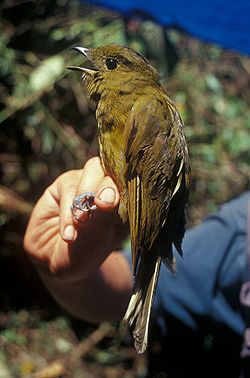| Snowornis | |
|---|---|
 | |
| Olivaceous piha (Snowornis cryptolophus) | |
| Scientific classification | |
| Kingdom: | Animalia |
| Phylum: | Chordata |
| Class: | Aves |
| Order: | Passeriformes |
| Family: | Cotingidae |
| Genus: | Snowornis Prum, 2001 |
| Type species | |
| Lipaugus subalaris (grey-tailed piha) Sclater 1861 | |
Snowornis is a genus of birds in the family Cotingidae. The species were formerly included in the genus Lipaugus ,
The genus Snowornis was introduced in 2001 by Richard Prum with the grey-tailed piha as the type species. The name was chosen to honour the ornithologist David W. Snow. His name is combined with the Ancient Greek ornis meaning "bird". [1] The genus is sister to the genus Carpornis which contains the two berryeaters. [2]
The genus contains two species. [3]
| Image | Scientific name | Common name | Distribution |
|---|---|---|---|
 | Snowornis cryptolophus | Olivaceous piha | Colombia, Ecuador, and Peru. |
 | Snowornis subalaris | Grey-tailed piha | Colombia, Ecuador and Peru. |
